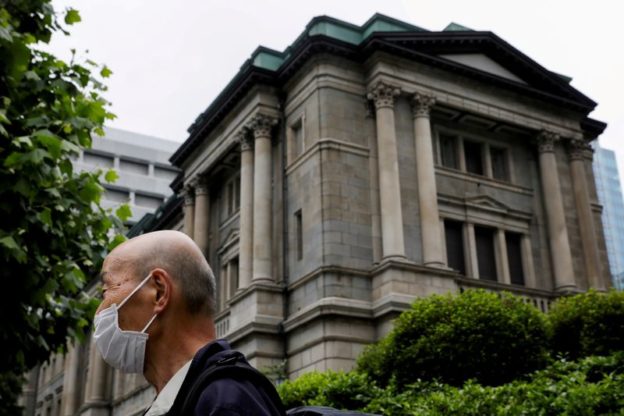© Reuters. FILE PHOTO: A man stands in front of the headquarters of Bank of Japan in Tokyo, Japan, May 22, 2020. REUTERS/Kim Kyung-Hoon
By Leika Kihara
TOKYO (Reuters) – The Bank of Japan is set to maintain its massive stimulus programme on Thursday and slash this year’s inflation forecast in a sign it has no intention to follow other central banks eyeing exits from crisis-mode policies.
While rising raw material prices have pushed Japan’s wholesale inflation to a 13-year high, consumer inflation is stuck around zero as weak domestic spending prevents firms from passing on higher costs to households.
Anaemic inflation and Japan’s still-fragile recovery will give the BOJ enough reason to maintain its target for short-term interest rates at -0.1% and that for 10-year bond yields around 0% at its two-day policy meeting ending on Thursday.
In fresh quarterly projections, the BOJ is seen cutting this year’s growth and inflation estimates, but sticking to its forecast of a moderate recovery, sources have told Reuters.
“Globally, central banks are shifting toward responding to heightening inflation with rate hikes. But it’s hard to see the BOJ becoming hawkish,” partly because cost-push inflation alone won’t prop up inflation to its 2% target, said Hiroshi Ugai, chief Japan economist at JPMorgan (NYSE:) Securities.
Markets are focusing on whether BOJ Governor Haruhiko Kuroda will issue any warning against the yen’s recent weakness, which gives exports a boost but drives up already high import costs for retailers still reeling from the pandemic’s pain.
The dollar has hovered around 113.50 yen after hitting a four-year high of 114.585 yen on Oct. 20, prompting the government to call for “stable” currency moves.
The dollar/yen is still below the 125 level seen by analysts as Kuroda’s line-in-the-sand. But the yen’s real, effective rate fell roughly 4.7% this year to 70.4 in September, BIS data showed, underscoring Japan’s diminishing purchasing power.
With exports and output taking a hit from parts shortages and supply constraints, policymakers are hoping the Sept. 30 lifting of state of emergency curbs will prod households to boost spending and help achieve a sustained economic recovery.
“My hope is that Japan will gradually see pent-up demand materialise around year-end or the beginning of next year,” BOJ board member Asahi Noguchi told a recent briefing.
Disclaimer: Fusion Media would like to remind you that the data contained in this website is not necessarily real-time nor accurate. All CFDs (stocks, indexes, futures) and Forex prices are not provided by exchanges but rather by market makers, and so prices may not be accurate and may differ from the actual market price, meaning prices are indicative and not appropriate for trading purposes. Therefore Fusion Media doesn`t bear any responsibility for any trading losses you might incur as a result of using this data.
Fusion Media or anyone involved with Fusion Media will not accept any liability for loss or damage as a result of reliance on the information including data, quotes, charts and buy/sell signals contained within this website. Please be fully informed regarding the risks and costs associated with trading the financial markets, it is one of the riskiest investment forms possible.

Comments are closed